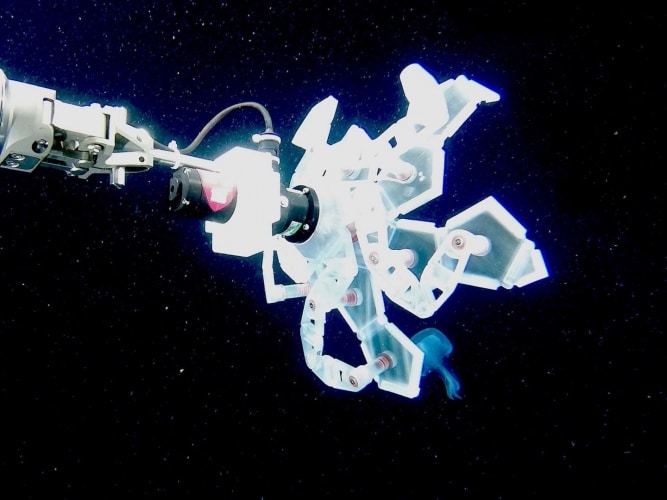
RAD (rotary actuated dodecahedron), was developed by a team from Harvard University’s Wyss Institute for Biologically Inspired Engineering, John A Paulson School of Engineering and Applied Sciences (SEAS), Radcliffe Institute for Advanced Study, and the City University of New York's Baruch College. It is designed for midwater interaction using rotary-actuated folding polyhedrons to quickly and safely capture marine organisms such as jellyfish and octopuses. The device, described in Science Robotics, consists of five identical 3D-printed polymer "petals" that are attached to a series of rotating joints that link together to form a scaffold. The structure rotates at its joints and folds up into a hollow dodecahedron when a single motor applies a torque at the petals’ meeting point.
"We approach these animals as if they are works of art,” said David Gruber, Presidential Professor of Biology and Environmental Science at Baruch College and co-author of the study. “Would we cut pieces out of the Mona Lisa to study it? No - we'd use the most innovative tools available. These deep-sea organisms, some being thousands of years old, deserve to be treated with a similar gentleness when we're interacting with them."
Zhi Ern Teoh, a former Wyss Postdoctoral Fellow, got the idea to apply folding properties to underwater sample collection in 2014. "I was building microrobots by hand in graduate school, which was very painstaking and tedious work, and I wondered if there was a way to fold a flat surface into a three-dimensional shape using a motor instead," he said.
According to Teoh, the design is perfect for the difficult and unpredictable deep sea environment "because its controls are very simple, so there are fewer elements that can break. It's also modular, so if something does break, we can simply replace that part and send the sampler back down into the water," he said. "This folding design is also well-suited to be used in space, which is similar to the deep ocean in that it's a low-gravity, inhospitable environment that makes operating any device challenging."
The team is currently working on a more rugged version of the device, while also adding further capabilities.
“We'd like to add cameras and sensors to the sampler so that, in the future, we can capture an animal, collect lots of data about it like its size, material properties, and even its genome, and then let it go, almost like an underwater medical check-up," said Gruber.




Poll: Should the UK’s railways be renationalised?
Is there anything fundamentally wrong in running a nationalised industry as a business for profit and then using a share of those profits to offset...